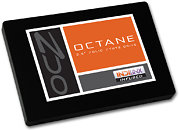Wednesday, May 2nd 2012

OCZ Adds 1 TB Capacity to Octane Series
OCZ introduced a new high capacity variant of its Octane consumer SSD series, the OCT1-25SAT3-1T. Built in the 2.5-inch form-factor with SATA 6 Gb/s interface, the new Octane variant provides 1 TB of unformatted capacity. Based on the Indilinx Everest processor, the drive packs 25 nm MLC NAND flash, and utilizes 512 MB of DRAM cache. It is rated to provide sequential transfer speeds of up to 460 MB/s (reads), 330 MB/s (writes), with 4K read/write random access performance of up to 24,000 IOPS and 32,000 IOPS, respectively. All modern consumer SSD features are present, including TRIM, NCQ, ECC, and 256-bit AES data-encryption. Slated for mid-May, the Octane 1 TB by OCZ won't exactly be cheap.
Source:
Hermitage Akihabara

13 Comments on OCZ Adds 1 TB Capacity to Octane Series
better buy some lottery tickets
I’ve been running an SSD RAID 0 array for some time now and haven’t noticed a significant drop in performance. The last configuration was a 4x60GB 240GB SSD RAID 0 configuration. Principally using JMicron-JMF618 controller via Kinston SSDNow V Series SNV-S2 64GB units (and one OCZ Agility 60GB).
I think some of the thinking that goes into the idea that performance drops inevitably and quickly without TRIM may have been applicable to first gen SSD units and aren’t necessarily applicable now to modern SSD units. That’s not to say TRIM isn’t a welcome addition if you can make use of it.
Sandforce controller based SSD units can get overloaded under certain circumstances and the performance may not recover even after secure erasing but that is independent of whether it is run in a RAID configuration. Also worth noting about larger capacity of a Sandforce based SSD units:www.pcper.com/reviews/Storage/Corsair-Force-Series-3-and-Force-Series-GT-SSD-Full-Review
For what its worth, performance of my 4x64GB SSD RAID 0 array in HD Tune was something like 890MB/s max sequential reads. This is on Intel SATA 3G ports on an ASUS P67 Pro.